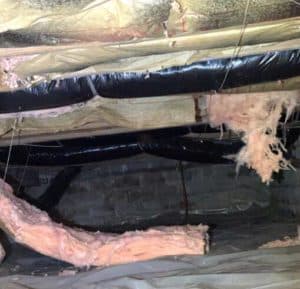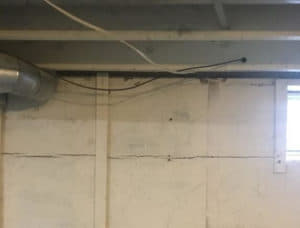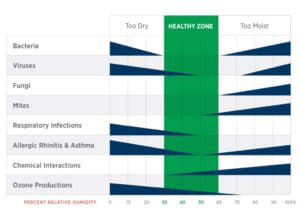
Originally posted 1/25/19, updated 10/27/21
Since heat rises, basements are usually chilly compared to the upper floors. However, going downstairs should not feel like a visit to the frozen tundra! Having a major temperature difference between the main floor and the basement isn’t just uncomfortable for you; it can also have some negative consequences for your home and your health.
Acculevel is a family-owned and operated company that specializes in foundation repair and waterproofing. Since we opened our doors in 1996, we’ve helped more than 35,000 homeowners preserve and protect their greatest investment. We provide whole-home solutions to our customers, repairing damages, preventing new issues from developing, and helping people reach their short and long-term goals for their homes.
In this article, we’re going to review five ways you can reduce the chill factor in the basement while also improving your health and the stability of your home.
This one may seem obvious, but you need regular preventative maintenance performed on your HVAC system. Schedule this in the fall, before you need the heat- but not until the worst of summer is done. You want your service person to have good working temperatures for the task.
Autumn in the Midwest means that we have mid-range temperatures (50𝆩-70°). This is cool enough to test the HVAC but not so cold you’ll be uncomfortable while the unit is being updated or repaired, if needed. It’s important that your HVAC equipment is efficient and well-maintained, but it also needs to be the right size for your home. If the HVAC is too small, it will have to work harder and run more often to reach the temperature.
Overworking an HVAC is a problem for multiple reasons. First, when it runs constantly, your utility bills will be painfully high. And second, an overworked piece of equipment is likely to burn out, forcing you to spend money or repairs or a replacement.
If you do need to buy a new HVAC, make sure you check with your furnace contractor and local utilities. There are often tax breaks or other incentives to help homeowners offset costs when they install more energy-efficient equipment.
There are a variety of portable space heaters available, all much safer than the kerosene-powered type our parents used. But they should still be used with caution. Never leave a space heater running unattended, plug it directly into a wall outlet (no extension cords), and keep the space around it clear of obstruction. There are many items that may not be truly flammable that can still melt or smoke; the fumes this gives off can be harmful.
Basements often don’t have insulation installed, because several inches of concrete is a pretty good insulator on its own. But drafts can form where the wooden flooring structure meets the concrete foundation.
Wood is not a very good insulation material, as it shrinks and expands with temperature fluctuations. This movement can create small gaps that allow a draft to develop or water to intrude. Components like the sill plate or bandboard can also sometimes come into direct contact with the outside soil, adding more dampness to the equation.

This is an illustration of the wooden structure under your main floor.
We recommend that you install spray foam insulation between the joists instead of the old school fiberglass type. There are a number of reasons why. Spray foam repels water, while fiberglass insulation absorbs moisture. Spray foam begins as a liquid, which means it can reach into and fill every single crack or gap without needing to be fastened in place. Fiberglass needs fasteners, and these often fail over time. We see this often in crawl spaces, where fiberglass insulation is a major problem.

This photo was taken by an Acculevel project advisor during an in-home appointment. The fiberglass insulation is damp, molding, and falling out of the floor joists.
Foundation cracks are an issue all by themselves, because they indicate structural problems like uneven settling. They can also be caused by hydrostatic pressure, which is created by water over-saturating the ground.
Once foundation cracks start to let in cold air and moisture, you have even bigger problems. Cracks large enough to allow intrusion will keep widening, which further damages the foundation while also making your basement cold and damp.
Repairing cracks is best done with an epoxy, as long as the wall isn’t bowing or shearing. If the wall is starting to move, carbon fiber straps are the ideal solution. If water is getting into your basement, water drainage is an important option as well.

This photo was taken by an Acculevel project advisor during an in-home appointment. The long horizontal crack is a warning sign that hydrostatic pressure is starting to push the wall inward.
Moisture or water intrusion will lead to other, health-related issues. If you regularly have moisture in your basement? You have mold, mildew, or other biological growth developing.
You may be thinking, why do I need a dehumidifier in the winter? But moisture can be a problem year-round. It can seep in through cracks in your foundation, or even through the concrete walls themselves. Remember, concrete is a porous material; this means if it tries hard enough, water can find its way through your walls.
Condensation is also another source of moisture in a basement. Whenever there’s a contrast between the temperature of the ground outside and the foundation inside, condensation is going to form. This is another nutrient source for the biological growth we mentioned in the previous section. A dehumidifier can keep this moisture in check, which can be essential for your health.
The American Society of Heating, Refrigerating and Air-Conditioning Engineers performed a study that demonstrated a humidity level of 50% is the ideal level for our homes. With this percentage of humidity in our air, all sorts of allergens, bacteria, viruses, and fungi are discouraged or outright destroyed.

This chart illustrates the results of ASHRAE’s study.
Many homeowners think encapsulation is something only used in crawl spaces. But this isn’t true; encapsulation is an excellent solution for many basements. If you have water intrusion on your basement walls, or you’re considering converting part of your basement into a finished space, encapsulation will keep the moisture close to the wall and route it down into the installed water drainage system.
Additionally, if you have an older home with a brick or stone foundation? Encapsulation is the ideal way to keep your basement clean and dry. Brick and mortar are more porous than concrete, so if you have water intrusion in a brick or stone basement, you can expect water to make a regular appearance.

This photo was taken by an Acculevel crew member after installing encapsulation in a brick basement.
Your foundation is a critical component of your home’s overall structure and stability. Keeping your basement in good shape will protect you, your family, and your greatest investment. We understand the significance and the importance of your home’s well-being, and we want to help you preserve and safeguard it for the future.
If you live in Indiana or the surrounding areas, please give us a call at 866-669-3349. We will schedule an appointment for you with one of our experienced and knowledgeable project advisors. They will discuss your concerns, your plans for your home in the future, and what symptoms you’ve observed and where. They will then perform a detailed in-home assessment, review their recommendations, and help you determine the best whole-home solution for you and your family. (If you prefer to communicate electronically, you can fill out this online form, instead!)
If you don’t live in our service area, please make sure the contractor you work with is reputable, properly insured, and accredited by the Better Business Bureau.
Need more information about foundation repair or basement waterproofing? We have additional resources to offer you, free of charge. Our homeowner guides are detailed, thorough, and updated regularly.
 |
 |
[DISPLAY_ULTIMATE_SOCIAL_ICONS]